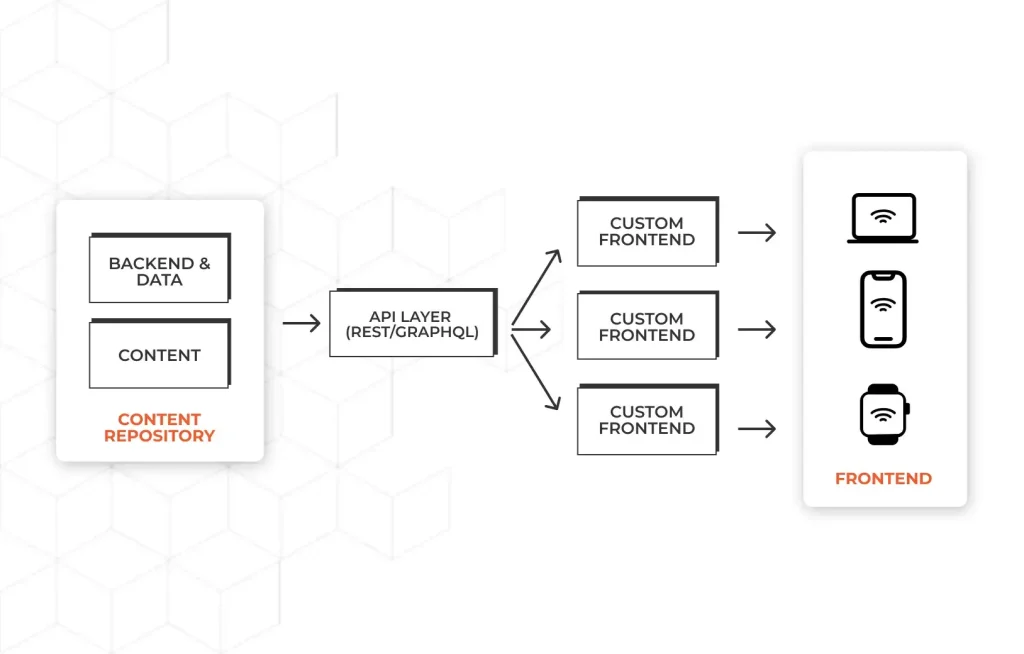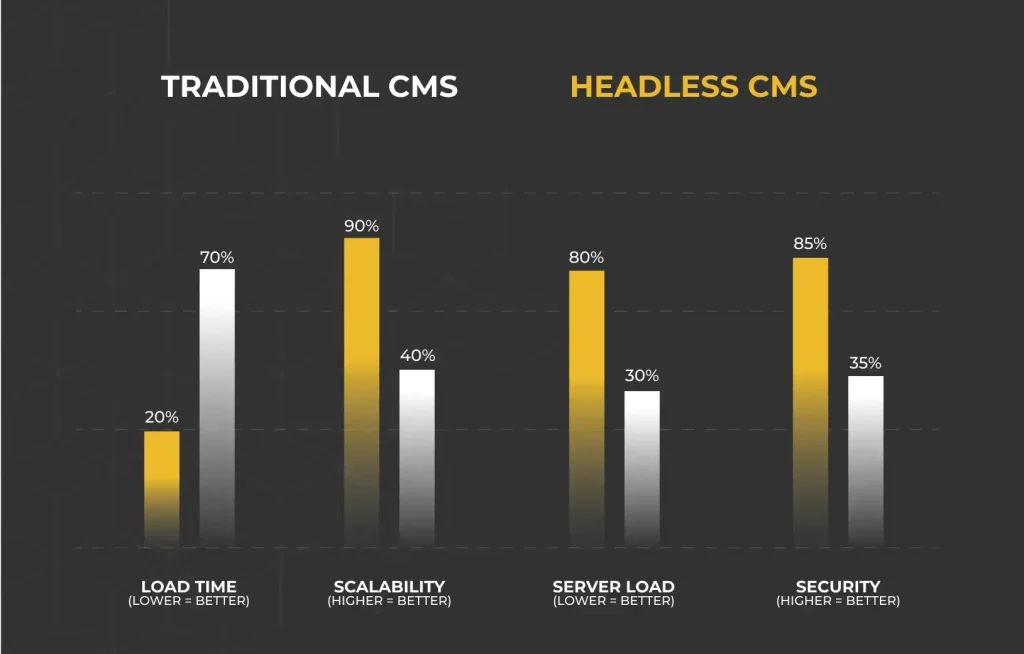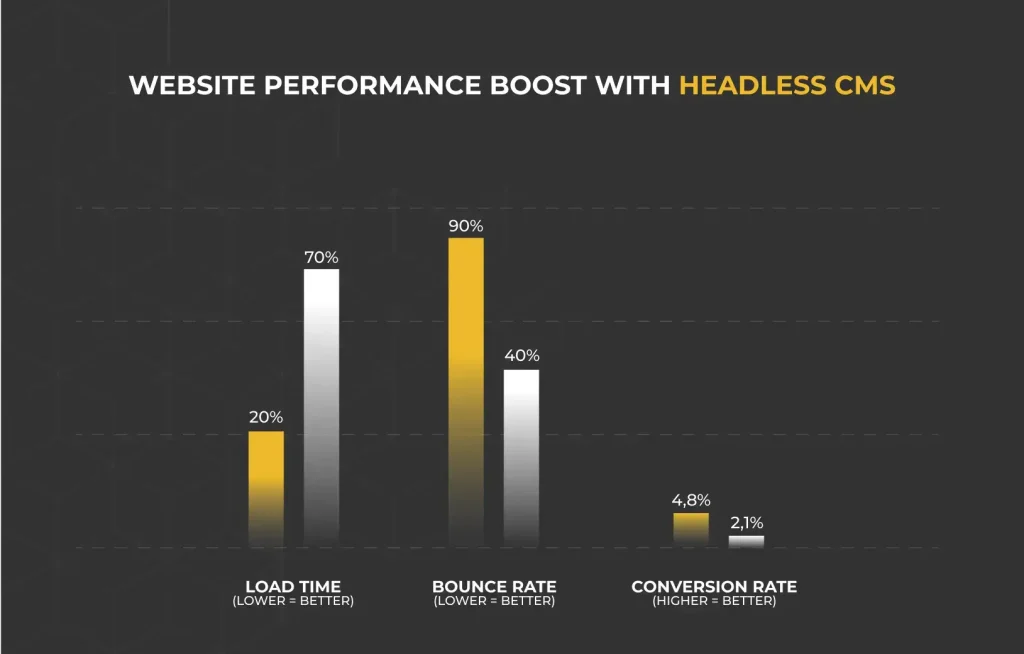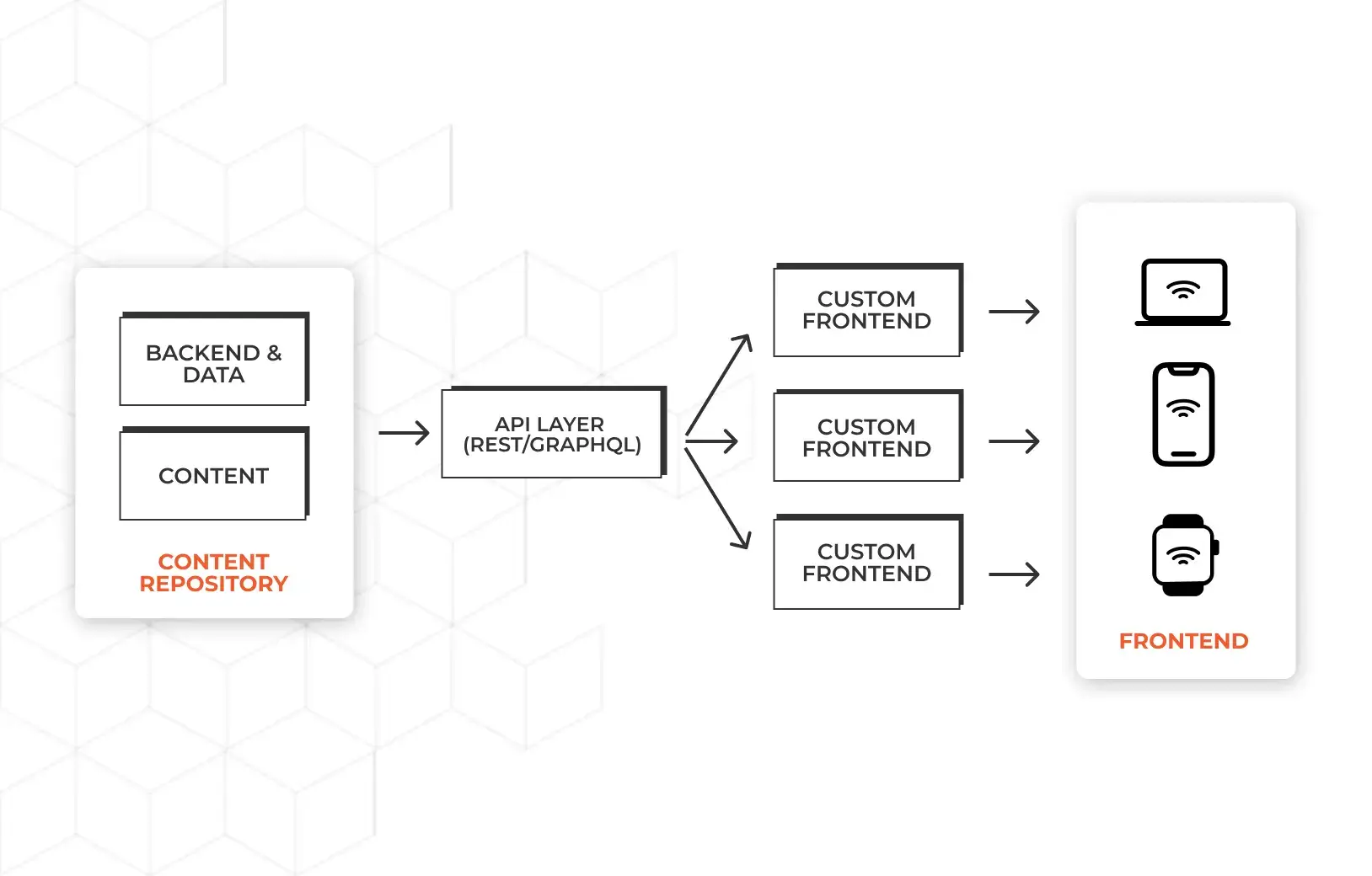Key Takeaways
- Separating the backend from the front end enables faster content delivery and greater flexibility.
- Headless architecture reduces server processing, optimizes caching, and allows asynchronous content loading, significantly improving load times.
- A headless CMS makes scaling content across websites, mobile apps, and IoT devices easy without backend limitations.
- Modern frameworks like Next.js, Nuxt.js, and React improve performance through server-side rendering, static site generation, and efficient code splitting.
- By adopting headless CMS, companies like Burberry and LADbible experienced up to 80% faster publishing speeds and 50% quicker page loads.
- Code splitting, asset optimization, API caching, and CDN integration create fast, efficient web experiences.
In a modern digital economy, website performance is no longer optional—it’s a business imperative. Research shows that even a 0.1-second improvement in load speed can boost conversions by 10%.
As customer expectations rise, traditional CMS platforms struggle to keep up, slowing content delivery and frustrating users.
This is where headless CMS architecture changes the game.
It splits content management from content display. Your back end handles the content, while your front end focuses on fast, efficient delivery through APIs.
This guide explains exactly how headless CMS frontend architecture speeds up websites. It includes examples of successful implementations, practical speed optimization techniques, and specific ways to improve your site’s performance.
Understanding Headless CMS Frontend Architecture
Headless CMS frontend architecture redefines website content delivery.
The separation between content management and presentation creates faster, more responsive digital experiences.
What Makes a Headless Front End Different?
Traditional CMS platforms bundle content presentation with backend operations – a limiting approach for modern websites.
Headless frontends break free from these constraints, connecting to content through API calls. Developers gain complete control over the user interface without backend restrictions.
The architecture stores content as structured data in cloud repositories. This setup powers content delivery across websites, mobile apps, and digital displays through one central platform.
Key Components of Headless Front End

Three core elements power the headless frontend system:
- Content repository: Houses structured content (JSON, HTML) in a centralized backend
- API Layer: Enables smooth frontend/backend communication via REST or GraphQL
- Presentation layer: Powers the user interface through React, Vue.js, or Angular frameworks
Content delivery networks (CDNs) distribute these components globally, speeding up website access worldwide.
Why It Matters
- Independent Scaling – Backend and frontend evolve separately.
- Flexible Development – Teams can iterate quickly.
- Global Delivery – Content is cached and delivered from the closest edge server (HTTP edge servers = geographically distributed nodes that serve content faster).
Content moves through the system in a precise sequence. User requests trigger API calls from the front end to the content repository.
The backend responds with structured JSON data, which the front end shapes into visually appealing pages using predefined templates.
This architecture delivers key advantages:
- Independent Scaling: Grow frontend resources without touching the backend
- Improved Performance: Load only necessary components for faster page rendering
- Flexible Development: Teams work independently on different system parts
Advanced features like code splitting and asset optimization enable sophisticated performance improvements. Developers can fine-tune caching strategies and optimize API responses for peak efficiency.
The modular design simplifies maintenance and updates. Teams can enhance specific components while maintaining system stability.
Omnichannel content delivery capabilities ensure consistent content presentation across devices. Your content adapts seamlessly between web browsers, mobile apps, and IoT displays.
This approach benefits large-scale applications the most. The front end handles traffic spikes efficiently while maintaining consistent user experiences across all digital channels.
Speed Benefits of Decoupled Front-end

Website speed directly impacts your bottom line.
Faster websites improve UX and directly impact revenue. A one-second delay can cut conversions by 7%, making performance optimization a critical investment for business growth.
Faster Page Load Times
A decoupled front end delivers content through smart asynchronous loading. Your users see critical content immediately while additional elements load behind the scenes. Small improvements yield big results—a minimal improvement of 0.1 seconds in load time can boost revenue by 10%.
Frontend-backend separation lets developers build interfaces that excel in:
- Precise image optimization
- Efficient script handling
- Quick server responses
- Reduced server processing
Smart architecture choices cut unnecessary code and database calls, leading to faster Time to First Byte (TTFB). Server load decreases because:
- APIs deliver structured content directly
- Distributed networks serve static files
- Client-server asset splitting reduces requests
Your website handles traffic spikes smoothly. During high-demand periods like flash sales or product launches, the system spreads visitor load across servers while maintaining consistent speeds worldwide.
Better Caching Options
Decoupled systems enable powerful caching strategies at every level. Smart caching implementation can slash page load times by 80%.
Strategic caching delivers:
- Browser-level caching: Local storage speeds up repeat visits
- CDN integration: Global content distribution cuts wait times
- API response caching: Fewer backend calls for common data
Developers set precise caching rules for different content types. Static assets like images stay cached longer, while dynamic content updates frequently.
E-commerce sites feel these benefits directly – one second of extra loading time can cost 20% of conversions. Strategic caching ensures quick page loads across devices and locations.
Static site generation adds another speed boost by pre-building pages for instant delivery. Combined with CDN distribution, your content reaches users from nearby servers, minimizing delays and maximizing performance.
Modern Frontend Frameworks in Headless Development
Framework selection shapes your headless website’s success. Modern JavaScript frameworks pack specialized features that boost development efficiency and website speed.
React and Next.js Benefits
Through its component-based architecture, React shines in headless CMS projects. Developers build reusable UI elements that scale efficiently. Next.js amplifies React’s power with server-side rendering (SSR) and static site generation (SSG)—must-have features for content-heavy websites.
Next.js paired with headless CMS delivers powerful advantages:
- Smart image optimization and code splitting
- SEO-focused HTML metadata handling
- Incremental Static Regeneration (ISR – Allows pages to update without rebuilding the entire site) for fresh content
Popular headless CMS platforms work seamlessly with Next.js. Strapi integration enables unlimited scaling and global reach. Sanity users benefit from full-stack capabilities through React Server Components and the app router.
Vue and Nuxt Performance Gains
Vue.js wins developers over with its HTML-based template syntax and gradual learning path. Single-file components bundle HTML, CSS, and JavaScript together, speeding up development cycles.
Nuxt.js enhances Vue with essential features:
- Powerful server-side rendering
- Smart code splitting
- Simple file-based routing
- Vuex state management (A centralized way to manage state (data) in Vue.js applications.) built-in
Strapi users find excellent results with Nuxt.js, creating high-performance, scalable applications through flexible content management. This combination helps teams build maintainable applications without sacrificing speed.
The framework scales without limits. Nuxt’s hybrid rendering combines static site speed with dynamic features. Content-heavy sites and blogs benefit most, especially when SEO matters.
Each framework suits different needs. E-commerce sites with frequent updates thrive on React and Next.js. Vue with Nuxt.js fits projects where clean code and easy maintenance lead priorities.
These frameworks reshape content delivery in headless CMS platforms. Their specialized features drive faster loading, better SEO results, and smoother user experiences across digital channels.
Real-World Speed Improvements

Want proof that a headless front end works? Major brands showcase measurable speed gains after switching to headless architecture. Their results paint a clear picture of performance improvements across industries.
Case Study: Burberry
Luxury retailer Burberry improved website speed and content publishing efficiency by 80%. Headless architecture allowed their team to launch campaigns faster and adapt to market demands in real time.
Support tickets plummeted from 40 weekly cases to less than one, and teams now publish content in 50 languages across global markets.
Case Study: LADbible
Digital publisher LADbible proves headless frontend’s worth in content delivery. Their switch to headless yielded impressive results:
By adopting a headless CMS, LADbible scaled to 55 brand sites with minimal infrastructure changes, reducing operational costs and increasing ad revenue through faster content delivery.
Case Study: Taxfix
Tax software provider Taxfix adds another success story after implementing a headless CMS. They achieved a 30% increase in website loading speed, translating to a more responsive and user-friendly customer experience.
Whereas content updates on the Taxfix website typically took two weeks, headless CMS now only takes five minutes.
Speed Metrics Comparison
Hard data backs headless frontend’s effectiveness.
58% of companies reported that switching to a headless CMS saved them time in content management and increased productivity
Speed gains show up across key areas:
- E-commerce performance: Mobile conversions improve with headless architecture. Better user experience and quick loading drive these gains.
- Core web vitals: Google’s speed standards set clear targets:
- Cumulative Layout Shift (CLS): 0.1 or less
- Largest Contentful Paint (LCP): Under 2.5 seconds
- First Input Delay (FID): Maximum 100 milliseconds
These improvements directly affect revenue. A site making $100,000 daily risks $2.5 million yearly losses from one second of extra loading time. Small gains matter—0.1 seconds faster loading can lift conversion rates by 7%.
Photo printing service Photobox cut page load time in half with headless CMS. This upgrade fixed their system errors and simplified content management.
Frontend Optimization Techniques
Smart optimization techniques target three critical areas: code management, asset handling, and caching systems. These methods work together to deliver the fast, smooth experience your users expect.
Code Splitting Strategies
Break down large JavaScript files into smaller pieces:
- Dynamic imports load only when users interact with specific parts of the page.
- Route-based splitting ensures that only needed routes are loaded at first.
- Component-level splitting keeps resource use lean and efficient.
Tip: Tools like Next.js support this natively for better load performance.
Asset Optimization
Smart asset handling forms the foundation of fast-loading websites. Headless CMS platforms excel at image optimization through:
- Image processing: Smart size and quality adjustments for each device
- Format selection: Modern formats like WebP cut file sizes
- Delivery optimization: Lazy loading reduces initial page weight
Static files load faster through distributed servers, putting content closer to your users. Your site performs consistently well regardless of visitor location or device choice.
API response caching
Store and serve data more efficiently:
- Browser-level caching: Local storage speeds up repeat visits
- Server-side caching: Less database strain through smart data storage
- Edge caching: Content sits closer to users via HTTP edge servers (Servers located closer to users to deliver content faster)
Smart HTTP headers and strategic cache timing balance fresh content against server load. This approach benefits high-traffic sites with frequent updates.
CDN integration lets headless CMS platforms cache components locally. Strategically placed cached copies help your content reach users faster.
These optimization methods deliver real results. Proper caching alone can slash page load times by 80%. Smaller files and fewer server requests boost performance across devices.
Modern frameworks like Next.js and Nuxt.js complement these strategies with built-in optimization features. Together, these techniques create fast, scalable websites ready for future growth.
Conclusion
Want faster websites that drive actual business results? Headless CMS frontend architecture delivers precisely that.
Your website speed optimization efforts gain new power through decoupled systems, modern frameworks, and precise optimization techniques.
Quick-loading pages mean happy users and healthy profits. Make headless frontend architecture your competitive edge in today’s speed-focused market. Start small, track your gains, and build toward a fully optimized system.
Your users will thank you for their engagement – and their business.
Struggling with slow load times and outdated CMS performance? Our headless CMS experts can help.
Get a free website performance audit today and uncover the bottlenecks holding your business back. Let’s future-proof your digital presence—schedule a consultation now!
Contact our web development experts for a performance audit of your current site. Let’s future-proof your digital presence—schedule a consultation.
FAQs
Is a headless CMS frontend faster than a traditional CMS?
Yes, headless CMS frontends typically offer faster performance. By allowing developers to optimize the front end independently, they can improve page load times and Time to First Byte (TTFB). This results in quicker loading times and a more responsive user experience.
What are the key benefits of using a decoupled front end for headless CMS?
The main benefits include faster page load times, reduced server processing, and better caching options. This architecture allows for independent scaling, enhanced performance through optimized content delivery, and flexible development across multiple platforms and devices.
How do modern frontend frameworks enhance headless CMS development?
Frameworks like React with Next.js and Vue with Nuxt.js offer specialized features that boost performance. They provide server-side rendering, static site generation, and built-in optimizations—this results in faster page loads, improved SEO, and enhanced user experiences across various digital platforms.
Can you provide examples of real-world speed improvements with headless CMS?
Yes, several companies have seen significant improvements. For instance, Burberry experienced an 80% increase in publishing speed after implementing a headless CMS solution. Another example is LADbible, which doubled its editorial process speed and successfully managed 55 brand sites without performance issues.
